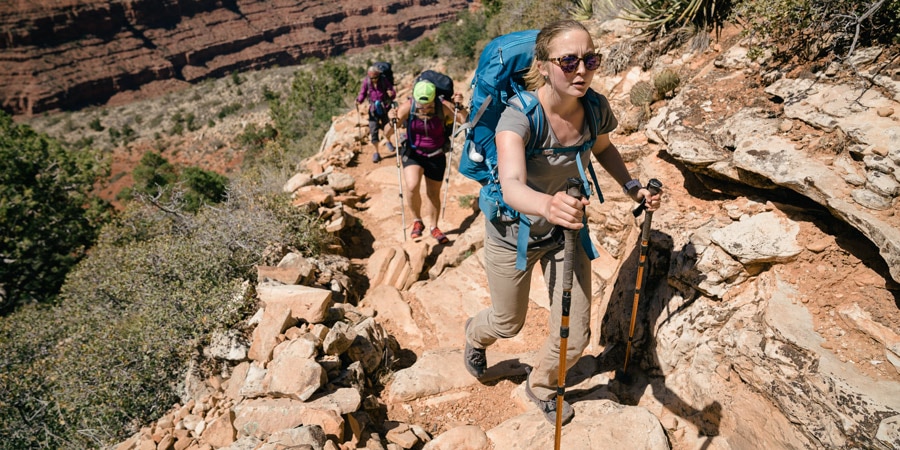As rewarding as backpacking can be, it also demands a lot from your body. Even if you carry a featherweight pack to ease the load, the miles won't hike themselves. Spend some time prepping your body before your trip and you're more likely to end each trail day happily fatigued, rather than miserably sore and exhausted.
This workout plan is designed to target areas that bear the brunt of the load on the trail. The goal is to increase strength in your core and major leg muscles, and to increase endurance in those same muscle groups.
Here's a quick, general overview of how to train for backpacking:
- Increase strength in major muscles that do the heavy lifting. Stronger legs and core muscles can support heavy loads, while also helping you power up the trail.
- Build endurance in those same muscle groups, as well as the shoulders and lower back, because backpacking is an all-day activity.
- Improve your balance so you have a more stable base that will allow you to take uneven terrain in stride.
- Don't forget your cardio. Complement any strength-training plan with activities like trail running, biking or another aerobic exercise that you enjoy.
Before beginning any training plan, check in with your doctor or certified training professional.
Training Schedule for Backpacking
Start training 8 weeks before you'll be backpacking. A good mix of workout types for each week involves the following (but feel free to modify this schedule to fit your needs):
- 2 nonconsecutive days of strength training (exercises in this article).
- 2 nonconsecutive rest days; take more any time you feel your body needs it.
- 3 nonconsecutive cardio sessions up until 2 weeks beforehand.
- Two weeks before your trip: Change your cardio days to long day hikes (60+ minutes each) with a pack that weighs about 80% of the weight you'll be carrying on your trip. Also add a fourth day-hike training session to one of your strength-training days.
- One or two days prior to your trip: Ease up on all training.
Training Exercises for Backpacking
Keep the following in mind as you train:
- Make the exercises fit your body, not the other way around.
- If something hurts, modify the exercise or skip it—and take extra rest days if you feel the need
- Move at your own pace, going slowly at first.
- Increase the repetitions or add more resistance or weight as your training progresses.
Warm up:
Get yourself warmed up by doing an easy 5- to 10-minute walk or jog. Then follow the guidelines below as you progress through the exercises in this article:
- Inhale during initial exertion, then exhale as you return to the starting position. During faster exercises, simply make sure you breathe regularly.
- Rest for 30 to 45 seconds at the end of each exercise (unless otherwise noted).
- Do each of the exercises below one time in succession, then rest for two minutes and repeat another set of all the exercises (if you have time to fit in a third set of exercises, that's even better).
Jump Squats
Squats are a staple of many exercise routines because they provide an excellent all-around workout for all of the muscles in the lower body and legs—your body's backpacking engine. Adding a jump helps develop power in the lower legs.
Props: None
- Start with your feet shoulder-width apart and then squat down until your thighs are at least parallel with the ground.
- Keep your chest up, your feet flat and your knees over your toes.
- As you come up from the squat, push through your heels, explode up and jump a few inches off the ground.
- Land softly and quietly, and immediately go into another squat.
- Do 15-20 times.
Hip Roll Exercise
Most of your backpack weight rides on your hips. This exercise works the glutes and other muscles that support the hips to improve their stability and endurance.
Props: None
- Stand on your left leg.
- Lean your body forward at your hips, keeping your back straight, and lift your right leg back behind you, slightly off the ground.
- Rotate (roll) your hip away from your standing foot.
- Keep your body in a straight plane as you roll your hips back.
- Repeat 10-15 times on each side.
Tips and modifications: If it's too hard to balance, hold onto the back of a chair or keep your toes on the ground.
Step Up Exercise
Hiking with a backpack involves a seemingly endless amount of stepping up and over things. This exercise builds strength and endurance in your glutes and quad muscles so you can handle whatever obstacles you'll encounter along the trail.
Props: A stable surface, about 8 inches off the ground. If you have a training box or an aerobic step at home, you can use that. If not, the bottom step on a flight of stairs can also work.
- Start with your left foot on the ground and your right foot on top of the step; your right knee will be bent.
- Step up until you are standing with your right leg nearly straight and you are balanced on top of the stop; your left leg should be bent slightly and your left foot poised an inch or so above the step.
- Pause in a balanced position, then step down, returning your left leg and right foot to the starting position.
- Do this 15 times; then repeat the exercise 15 times on the other side.
Tips and modifications: Adjust the difficulty by finding a higher or lower (stable) surface to step on.
You can also wear your weighted backpack when you do this exercise. Start with 10 pounds or so, then add a few more pounds each week until you get to about 80% of your anticipated pack weight.
Heel Down Exercise
To get down after you step on top of boulder or a log, you need to be able to lower your body and pack weight under control. That's key to preventing knee injuries and stumbles. This exercise works your glutes and quad muscles so you have the strength and the balance to do that smoothly and efficiently.
Props: A stable surface, about 8 inches off the ground. If you have a training box or an aerobic step at home, you can use that. If not, the bottom step on a flight of stairs can also work.
- Start by standing on top of a step, balanced on your right foot with your left foot hovering to the side.
- Lift the toes on your left foot up, then bend your right knee as you slowly lower your left leg until your left heel is barely touching the ground or poised just above it.
- Power back up with your right leg until you are back to the starting position.
- Do this 15 times; then repeat the exercise 15 times on the other side.
Tips and modifications: Adjust the difficulty by finding a higher or lower (stable) surface to step on.
You can also wear your weighted backpack when you do this exercise. Start with 10 pounds or so, then add a few more pounds each week until you get to about 80% of your anticipated pack weight.
Single-Leg Deadlift Exercise
This exercise engages your hips and core muscles to develop strength and balance as you center your weight over each side of your body.
Props: A lightweight dumbbell
- Stand with feet shoulder-width apart, holding a dumbbell in your left hand.
- Centering your weight over your right foot, bend forward at the hips as you extend your left leg backwards; maintain your balance as you lower the dumbbell toward the floor. Do not let your hips rotate.
- Raise back up to the start position by squeezing your glutes; your core should remain engaged and your back should remain straight.
- Do this 20 times; then switch to your other side and do 20 reps.
Tips and modifications: Adjust the difficulty by adjusting how high far down you bend toward the floor. You can also use a lighter or heavier dumbbell.
Squat Curl Overhead Press Exercise
This exercise combines a squat to work lower body muscles with a quick lift of moderate weight to build the strength you'll need to heft your backpack multiple times along the trail.
Props: A pair of lightweight dumbbells
- Stand with feet shoulder-width apart, arms at your side, holding a dumbbell in each hand.
- Press your hips back and squat down as if you're about to sit on an invisible chair. Try to bring your thighs parallel to the floor.
- Power back up to a standing position, using your upward momentum to assist you as you curl up and then press the dumbbells overhead (with palms facing each other the entire time).
- Return to starting position and repeat 10-15 times.
Tips and modifications: Keep your back and neck in a neutral position; try not to round your shoulders or crane your neck forward throughout this exercise. Also, try not to let your knees go past your toes when you're squatting.
Lift Exercise
Not all backpacking movement is in a straight line, so this exercise prepares you for twists and turns in the trail. It develops balance and core rotational power by strengthening your upper and lower abdominals and obliques, along with your glutes and leg muscles.
Props: A medium-resistance exercise band
- Secure one end of the band at ankle height.
- Standing sideways to the where the band is anchored, position yourself so that when you grab the end of the band with both hands, there is tension in the band.
- Rotate your torso upward to the right, pulling the end of the band at an upward angle across the front of your torso; let your feet pivot until you are facing in the opposite direction with your arms straight in front of your body. Also rotate the leg closest to where the band is anchored slightly while pushing up onto the toe of that foot.
- Return to the starting position while maintaining an even tension in the band.
- Through this entire motion, your core muscles should be powering the movement. Your shoulders should stay square and your hips should remain aligned, and your elbows and wrists should also remain as straight as possible.
- Do this 20 times; then do the same on the opposite side for 20 more reps.
Tips and modifications: Adjust band resistance level by shortening it to increase resistance or lengthening it to ease the resistance. Your goal is to feel fatigued at the end of your reps, but not so fatigued that you struggle to finish them.
Side Plank with Hip Dip Exercise
Backpackers often complain of lower back fatigue. This exercise combines a plank with hip movement to build up core endurance, which will help minimize low-back discomfort.
Props: None
- Lie on your right side, supported by your elbow under your shoulder. Your right forearm should be perpendicular to your body, and your left hand should rest on your left hip, with your left elbow pointing up. Your legs and feet should be stacked atop one another.
- Tighten your core as you raise your hips up into a plank, creating a straight line from your head to your feet.
- Slowly lower your right hip down and then back up to the plank position.
- Do this 10 times; then do the same on your left side for 10 more reps.
Tips and modifications: To make it easier, move your top leg slightly in front of your lower leg and use the foot on that leg for more support. You can also do the exercise with your knees resting on the ground.

